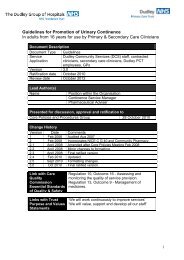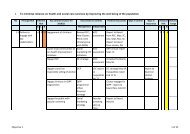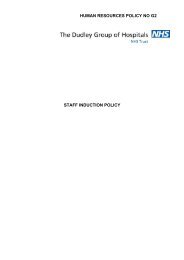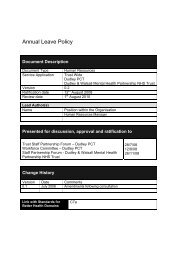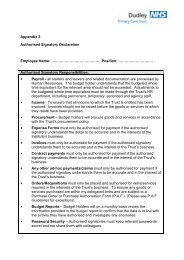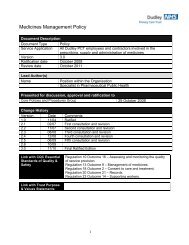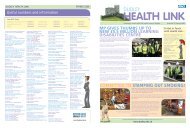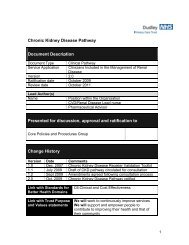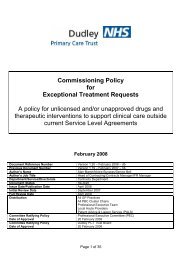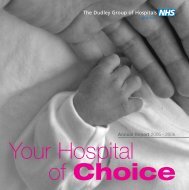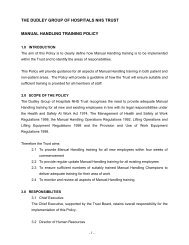Dudley Strategy for Tackling Health Inequalities 2010-15
Dudley Strategy for Tackling Health Inequalities 2010-15
Dudley Strategy for Tackling Health Inequalities 2010-15
- No tags were found...
You also want an ePaper? Increase the reach of your titles
YUMPU automatically turns print PDFs into web optimized ePapers that Google loves.
Key findings from analysis of emergency hospital admissions data using theICE matrixOverall emergency hospital admission rates due to accidents, suicides andundetermined injury are higher in males than females. Emergency hospitaladmission rates have increased over time and continue to do so particularly<strong>for</strong> suicides and undetermined injury in females.There is a health inequalities gradient <strong>for</strong> emergency hospital admissions fromexternal causes (higher rates in the most deprived areas) and this is morepronounced <strong>for</strong> males.The rise in emergency hospital admissions rates <strong>for</strong> accidents over the last 6years is most apparent in the over 75 age band with the main mechanismbeing falls and fractures. There has been an increase in admissions ratesacross all age bands and mechanisms.In 2004-2008 falls and fractures were the most common mechanism of injuryadmission, followed by poisoning and transport.In terms of deprivation the main mechanisms which show a negative socialgradient are poisoning (particularly ages <strong>15</strong>-54 <strong>for</strong> males and age 0-54 <strong>for</strong>females), transport <strong>for</strong> males where the negative gradient is prominent in the0-54 age band. Falls and fractures showed a smaller social gradient <strong>for</strong> malesand showed a no gradient <strong>for</strong> females over 75, but a negative gradient <strong>for</strong> theyounger age bands. Although the rate of admissions <strong>for</strong> drowning overall arelow they do all arise from the most deprived quintile mainly in the 0-4 ageband.How do we get there?In 1999, the Government White Paper Saving Lives: Our <strong>Health</strong>ier Nation (GreatBritain. Department of <strong>Health</strong>, 1999) set out the first comprehensive Governmentplan focused on the main killers: cancer, coronary heart disease and stroke,accidents, mental illness. It set out to establish tough but attainable targets in priorityareas. These were that by <strong>2010</strong> death rates accidents would be reduced by at least afifth and serious injury by at least a tenth and <strong>for</strong> mental health to reduce the deathrate from suicide and undetermined injury by at least a fifth. As seen earlier thesetargets are unlikely to be achieved both nationally and in <strong>Dudley</strong>. Additionally thesetargets are even more unrealistic in the lower socioeconomic groups.<strong>Dudley</strong> has had a Joint Accident Prevention <strong>Strategy</strong> Partnership since the year2000, and the current Joint Accident Prevention <strong>Strategy</strong> runs from 2009-2012 withannual action plans (<strong>Dudley</strong> MBC and <strong>Dudley</strong> PCT, 2009). The strategy to daterecognised the impact of health inequalities on accident and unintentional injuries,and the current action plan has key programmes that work across <strong>Dudley</strong> andaddresses the key areas highlighted in this needs assessment (Moss, <strong>2010</strong>).In terms of suicide and undetermined injury, these are covered in the NationalService Framework <strong>for</strong> Mental <strong>Health</strong> (Great Britain. Department of <strong>Health</strong>, 1999)which had seven standards of which Suicide Prevention was Standard Seven andMental <strong>Health</strong> Promotion was Standard One.175




